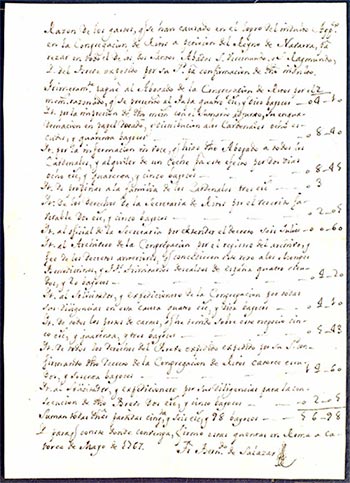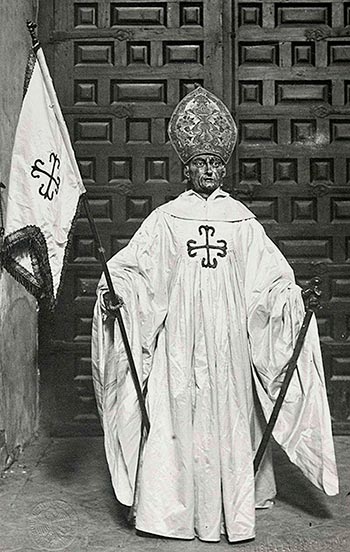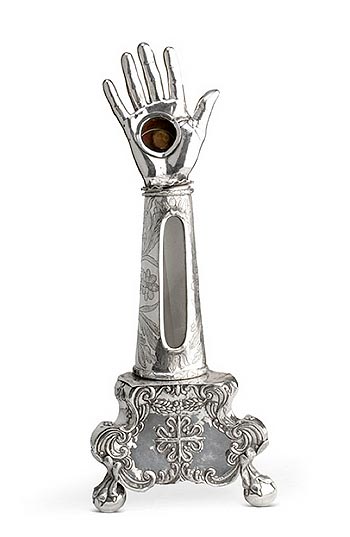The cult and official document of San Raimundo de Fitero in his monastery

FotoCedida/official document with the prayers of San Veremundo and San Raimundo for the Kingdom of Navarre, Pamplona, 1767. Private Collection
The cult of the first abbot of Fitero reached a major milestone at the end of the 16th century, when the abbot Fray Marcos de Villalba brought an important relic in 1590, taken from the body of the saint on the occasion of the transfer of his body to a new funerary monument, paid for by the aforementioned Fray Marcos. The relic was placed in the Romanist reliquary bust until it was transferred, well into the 18th century, around 1736, to a very beautiful silver reliquary. With this reliquary it was customary until the 19th century to go out to the foot of the church to ward off clouds.
However, the prayer and official document of the founder of the military order of Calatrava was gradually authorised for the Cistercian Order (1702), for the diocese of Tarazona (1728) and other religious orders, until 1800, when it was extended to the whole of Spain, at the request of Charles IV, by means of a Brief issued in Rome on 5 December 1800, extending the official document of his feast day to all the regular and secular clergy of both sexes in all the Hispanic dominions, with the category of double minor rite for 15 March.

receipt of the expenses incurred in Rome for the attainment of the offices of San Raimundo de Fitero and San Veremundo, 1767. file General of Navarre
The extension of the official document and prayer for the kingdom of Navarre was a fact in 1767. The decree of the Congregation of Rites that made it possible came about at the request of the Cortes of that Kingdom in session on 4th October 1765, in the cathedral's precious conference room , and was requested for both St. Raymond and St. Veremundo, abbots of Fitero and Irache. The initiative came from the abbots of both monasteries, who sat on the ecclesiastical arm. From the text of the petition to the Holy See, we can extract the following paragraph: "Desiring that the veneration of the saints... and Saint Raymond, abbot of the Royal Monastery of Santa María de Fitero and founder of the Military Order of Calatrava, presidium of the Christian religion against the Moors, be extended to all the towns of this Kingdom". The success of the efforts resulted in the decree of 1766 and the printing of the prayer the following year, with the appropriate licences signed by the Vicar General of the Diocese of Pamplona, Don Manuel de la Canal. The Kingdom's gratitude to the Sacred Congregation of Rites was recorded in the next Cortes, meeting , in 1780, which reported that the Diputación del Reino had satisfactorily resolved the mandate of the previous Cortes. The text, dated 21 January of that year in Pamplona, reads: "Thus, by Chapter 113, it is foreseen that, having obtained the Breves for the prayers of San Veremundo and San Raimundo, whose application was resolved in the last Cortes, by order of 4 October 1765, the Diputación should take the necessary steps for their fulfilment. The order has been entirely fulfilled, as it is recorded on fol. 14, lib. 18, that the Most Reverend Brother José Ruete, being Abbot of Irache, sent the Decree of the Sacred Congregation of Rites, granting the prayer for the whole Kingdom, and on fol. 74 that the Diputación passed the Decree on to the respective prelates".
Behind the whole process was Fermín de Lubián, prior of Pamplona Cathedral and a very prominent figure in 18th-century Pamplona. His tenacious investigations began in 1757 with an interesting correspondence with one of the canons of Toledo, surnamed Rodríguez, which we will deal with elsewhere. The prebendary could be related to Don Francisco Rodríguez Gálvez, from Toledo and a doctoral student in Tudela, who was involved in the negotiations when the construction of the chapel of Santa Ana was planned and influenced the chapter of the capital of La Ribera to order a large batch of carved silver from Toledo in 1715.

Dress sculpture for the processions of the monastery of Fitero, c. 1702, no longer extant.
Among the replies and endorsements requested by the institutions of Navarre, we would highlight that of the bishop of Tarazona, addressed to the Kingdom, initialled on 19 October 1765 and preserved in the file General de Navarra (Negocios Eclesiasticos, leg. 5, folder 28). In it he takes the opportunity to vindicate the Cistercian abbot as a canon of Thuriasona and writes: "I wish that my enclosed supplications concur with the religious aims of the discreet zeal that animates Your Most Illustrious Lordship, in whose interest in this pious matter, I have a particular interest, for the distinguished portion that belongs to my bishopric in this most illustrious kingdom, to promote with Your Most Illustrious Lordship the cult of Saint Ramon de Serra, canon of this martyr, my wife, whom he beautified so much with his virtues, as these were useful to the Cistercian Order, to Calatrava and to the whole Church".
Other documents are kept in the aforementioned file General of Navarre, such as the request for the payment of expenses incurred in Rome, the original Brief of the Pope on vellum (Negocios Eclesiásticos, leg. 5. folder 36) or the form certificate by the Vicar General of the Diocese of Pamplona, Manuel de la Canal on the copy of the aforementioned pontifical document (Negocios Eclesiásticos leg. 5, folder 37).
The expenses in the Roman Curia were subscribed in May 1767 by the monk Friar Bernardo de Salazar and contain items relating to items such as: the lawyer of the Congregation of Rites, the printing of the memorial and its binding, the gratuities to the cardinals' relatives, the administration fees, the issue of the decree and the archivist of the Congregation for the registration fees. The curious receipt is also preserved in the file General de Navarra (Negocios Eclesiásticos, leg. 5, folder 38).
 |
 |
| Reliquary bust of the saint in the monastery of Fitero, possibly the work of Bernal de Gabadi, c. 1590. Photo J. L. Larrión |
Sculpture of Saint Raymond in the altarpiece of Saint Teresa in the monastery of Fitero, by José Serrano, 1730. Photo J. L. Larrión |
In the monastery of Fitero, with the authorisation of worship in 1702 for the entire Cistercian order, acts of worship must have increased considerably. Firstly, the monastery was given an altarpiece presided over by a candlestick image with a very expressive head, preserved and carried in procession until 1965. The aforementioned altarpiece was polychromed by the gilder Juan Preciado with seven hundred gold leafs brought from Pamplona and four hundred silver leafs, which were also used to decorate the processional platforms and some axes. Later, in 1730, another polychrome wooden sculpture was placed in the main body of the great altarpiece of Saint Teresa, at Wayside Cross north of the abbey church. The contract for its execution was signed in October of the aforementioned year of 1730, and he undertook to deliver the finished work in August 1732 for the sum of 2,200 silver reales. With regard to the figure of the first abbot of Fitero, it is specified in the aforementioned document that a "Saint Raymond with a staff in his left hand and a flag in his right hand" would be sculpted. This is what Serrano did in a beautiful image in which the abbot's content clearly dominates, with an idealised face, a wide Cistercian chasuble with long sleeves and the cross of Calatrava. The polychromy with rich gold in the vestments and polished incarnations enhances the value of this sculpture with its open lines, its arms spread out to hold the flare, symbol of its authority, and the flag, emblem of the Order of Calatrava.
With regard to the relic, set in a silver reliquary of subject arm with a beautiful base decorated with Calatrava crosses, we know from a document of 1810 that, among the duties of the sacristan was to "expose the arm-reliquary of San Raimundo, both by day and by night" on days of summer storms.

Silver arm-reliquary of the saint from the monastery of Fitero, c. 1736. Photo J. L. Larrión
To find out more
FERNÁNDEZ GRACIA, R., "Entre la historia, la leyenda y el mito. La imagen de San Raimundo, abad de Fitero y fundador de la Orden militar de Calatrava", Fitero: el bequest de un monasterio. Pamplona, Fundación para la Conservación del Patrimonio Histórico de Navarra, 2007, pp. 125-172.
